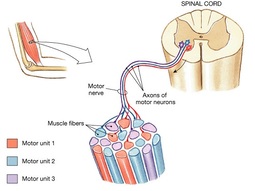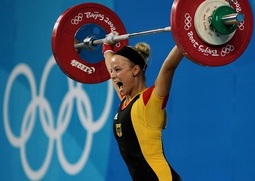Athlete
Board owner
02/04/2018 (Sun) 22:39:52
[Preview]
No.20
del


>2. Muscle: Activation and Neural Factors
The nervous system is extremely important in the use and development of muscular strength. Strength is determined not only by quantity of muscle mass but also the extent of which individual fibers in a muscle are activated. Elite athletes have superior coordination in activating single muscles and muscle groups due to adaptations of their nervous systems.
<Motor Units
Are the basic elements of motor system output. Each MU consists of a motoneuron on the spinal cord, and the muscle fibers it innervates. A long axon connects the motoneuron to the muscle, where it branches out to innervate individual muscle fibers. When a motoneuron is active, impulses are distributed to all connecting muscle fibers. In small muscles, motoneurons may connect to a dozen muscle fibers, affording precision movement. In large muscles, motonuerons may connect to thousands of fibers.
Like the muscle fiber they attach to, motor units can be classified as fast twitch or slow twitch. Slow twitch motor units have a low threshold to being activated, while fast twitch motor units have a high threshold to activation. Motor units are activated to the all-or-none law, where at any point in time a motor unit is either active, or inactive.
The nervous system varies force production through three variables: recruitment of motor units, changing the firing rate of motor units, and activating motor units in a synchronized fashion.
Recruitment
During voluntary contractions, the pattern of recruitment is controlled by the size of motoneurons. Small motoneurons with low firing thresholds are recruited first, with demands for higher force production being met with the recruitment of increasingly forceful motor units. The motor units with the largest motoneurons, which have the largest and fastest contractions, are recruited last. Because of their low firing threshold, slow twitch fibers are recruited for all movement regardless of force production.
Firing Rate
The other primary mechanism for gradiating muscle force is through the firing rate of the motor neuron. This firing rate can vary over a considerable range. In small muscles, most motor neurons are recruited by the 50% point of maximal force production, with the remaining 50% coming from an increase in firing rate. Larger muscles sees the top 20% of maximal force production come from increased motor unit firing rate.
Message too long. Click here to view full text.
Edited last time by Director on 02/04/2018 (Sun) 22:41:04.